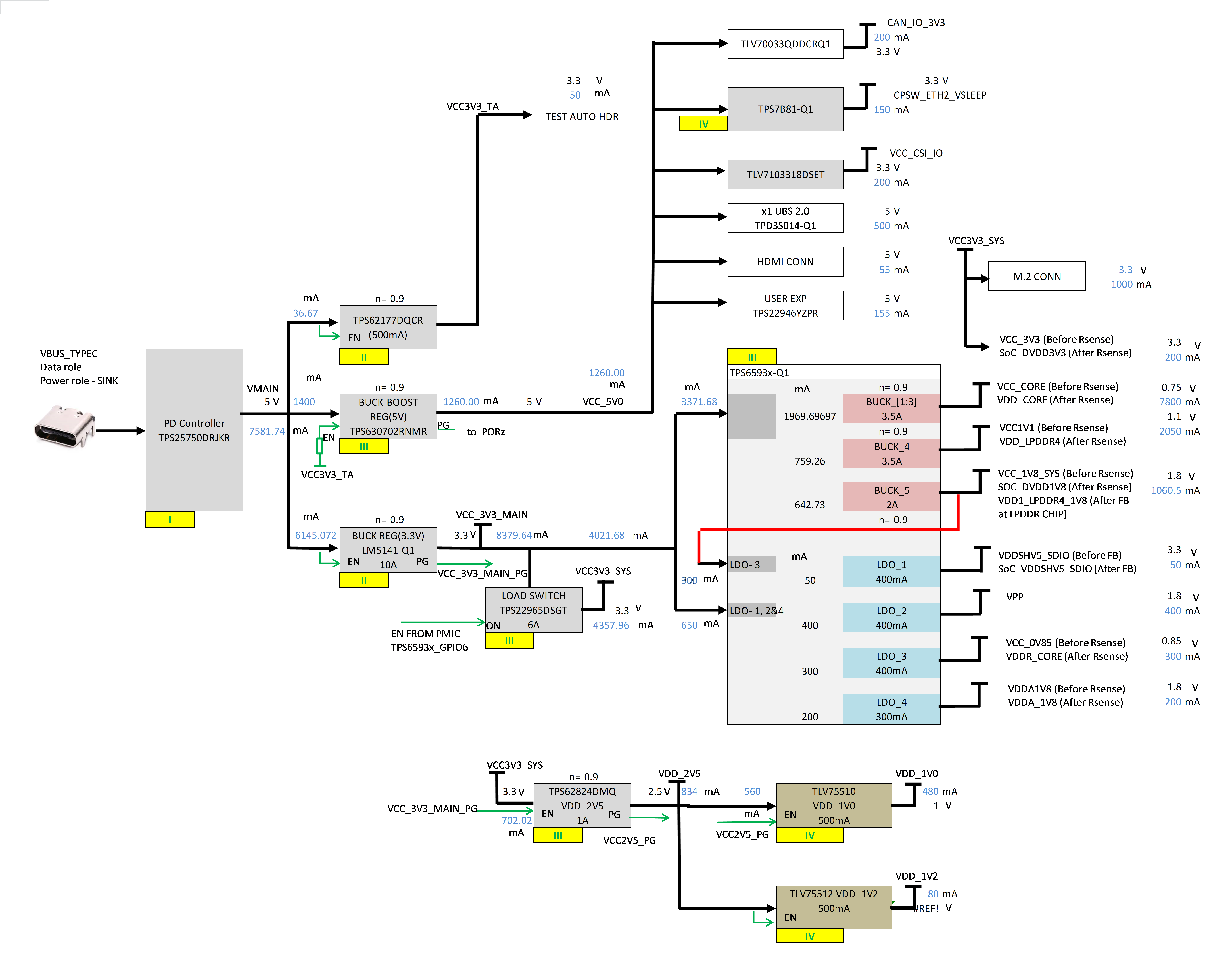SPRUJ66A February 2023 – December 2023
- 1
- Abstract
- Trademarks
- 1EVM Revisions and Assembly Variants
- 2Inside the Box
- 3EMC, EMI, and ESD Compliance
-
4System Description
- 4.1 Key Features
- 4.2 Functional Block Diagram
- 4.3 AM62A Low Power SK EVM Interface Mapping
- 4.4 Power ON/OFF Procedures
- 4.5
Peripheral and Major Component Description
- 4.5.1 Clocking
- 4.5.2 Reset
- 4.5.3 CSI Interface
- 4.5.4 Audio Codec Interface
- 4.5.5 HDMI Display Interface
- 4.5.6 JTAG Interface
- 4.5.7 Test Automation Header
- 4.5.8 UART Interface
- 4.5.9 USB Interface
- 4.5.10 Memory Interfaces
- 4.5.11 Ethernet Interface
- 4.5.12 GPIO Port Expander
- 4.5.13 GPIO Mapping
- 4.5.14 Power
- 4.5.15 AM62A Low Power SK EVM User Setup and Configuration
- 4.5.16 Expansion Headers
- 4.5.17 I2C Address Mapping
- 5Revision History
4.8.14.4 Power Supply
AM62A Low Power SK EVM utilizes an array of DC-DC converters to supply the various memories, clocks, SOC and other components on the board with the necessary voltage and the power required.
The figure below shows the various discrete regulators, PMIC and LDOs used to generate power rails and the current consumption of each peripheral on AM62A Low Power SK EVM board.
 Figure 4-30 Power Architecture
Figure 4-30 Power ArchitectureThe following sections describe the power distribution network topology that supplies the SKEVM board, supporting components and reference voltages.
The AM62A Low Power SK EVM board includes a power solution based on combination of PMIC and discrete power supply components. The initial stage of the power supply will be VBUS voltage from either of the two USB Type C connectors J13 and J15. USB Type-C Dual PD controller of Mfr. Part# TPS65988DHRSHR is used for negotiation of the required power to the system.
Buck-Boost controller TPS630702RNMR and Buck converter LM5141-Q1 are used for the generation of 5V and 3.3V respectively and the input to the regulators is the PD output. These 3.3V and 5V are the primary voltages for the AM62A Low Power SK EVM Board power resources.The 3.3V supply generated from the Buck regulator LM5141-Q1 is the input supply to the PMIC, various SOC regulatorsand LDOs. The 5V supply generated from the Buck Boost regulator TPS630702RNMR is used for powering the onboard peripherals. Discrete regulators and LDOs used on Board are:
- TPS62824DMQR– To generate VDD_2V5 rail for PHY and DDR peripherals
- TLV75510PDQNR– To generate VDD_1V0 for Ethernet PHYs
- TLV75512PDQNR– To generate VDD_1V2 for HDMI Framer
- TPS65931-Q1 (PMIC) – To generate various SoC and Peripheral supplies
- TPS62177 Regulator - Powering the always on circuits of Test Automation Section
- TLV705075YFPT LDO – VDD_CANUART power of SoC
- TPS79601LDO - XDS110 On board emulator
- TPS73533LDO - FT4232 UART to USB Bridge
- TLV7103318DSET LDO – CSI IO supply for MIPI camera boards
Additionally,GPIO from the test automation header is connected to the nPWRON/ ENABLE pin of PMIC to control ON/OFF of the SKEVM via the test automation board. It only disables the VCC_5V0 output of TPS630702RNMR from which several other power supplies are derived.